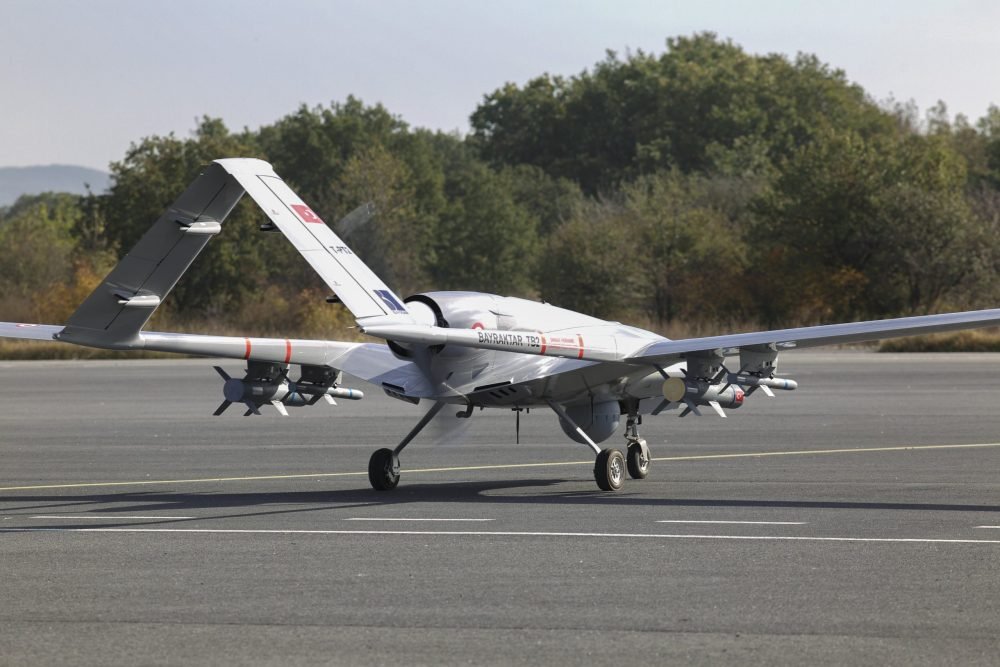Unmanned aerial vehicles (UAVs) and counter-unmanned aircraft systems (CUAS) were deployed on an unprecedented scale by both India and Pakistan during the 2025 conflict, which marked a turning point in the military history of South Asia. This transition heralds a new era of high-tech, low-cost, and deniable warfare, which fundamentally transforms the strategic calculus on the subcontinent.
The Drone War of May 2025
In May 2025, India and Pakistan conducted their initial extensive use of UAVs against each other during a four-day conflict. Hundreds of drones were deployed for reconnaissance, electronic warfare, and precision assaults. To avoid a large-scale escalation and demonstrate military resolve, both parties capitalised on drones’ capacity to strike without endangering pilots or inciting uncontrollable conflict.
Drone Capabilities: India vs. Pakistan
India’s drone inventory comprises the Israeli Searcher, Heron, Harpy, and Harop models; the Polish Warmate; a burgeoning collection of indigenous UAVs, and, most recently, the procurement of MQ-9B Predator drones. From the development of swarm tactics and surveillance to the suppression of adversary air defences (SEAD) and precision strikes, these platforms support a variety of missions. Standoff attacks and loitering munitions have been the primary focus of India’s ongoing efforts to develop swarm capabilities. India is investing at a rapid pace in drone technology on a domestic level, with a total of $470 million allocated to electronic warfare countermeasures and resilience. However, its supply chain remains vulnerable as a result of its dependence on Chinese components, including lithium batteries and magnets.
In contrast, Pakistan’s drone fleet is composed of Turkish Bayraktar TB2s, Songar drones, Chinese CH-4s, and indigenous Shahpar-II UAVs, as well as Turkish-origin YiHA-III and Asisguard Songar drones. Pakistan has reportedly launched 400 to 500 drones in a single operation and has integrated reconnaissance, signals intelligence (SIGINT), interference, and tactical loitering munitions into its operational doctrine, demonstrating the ability to conduct large-scale swarm attacks. Pakistan has been able to rapidly expand its capabilities and improve its technological foundation through the local assembly of Turkish drones and close collaboration with China and Turkey.
India is investing at a rapid pace in drone technology on a domestic level, with a total of $470 million allocated to electronic warfare countermeasures and resilience. However, its supply chain remains vulnerable as a result of its dependence on Chinese components, including lithium batteries and magnets
Significant Technological and Tactical Changes
The use of loitering and swarm munitions was one of the most noteworthy developments of the 2025 conflict. Pakistan demonstrated its ability to launch coordinated clusters of hundreds of drones, which effectively probed Indian air defences and collected electronic intelligence. Like the Ukraine conflict, both nations employed loitering munitions, including the Harop and Warmate, for precision strikes and SEAD missions. The centrality of electronic warfare (EW) capabilities in both drone deployment and CUAS operations was underscored by the use of drones to trigger adversary air defence radars, which facilitated follow-on jamming and cruise missile strikes.
Indian counter-UAS systems were comprised of electronic warfare suites, early-stage interceptor drone programs, and legacy anti-aircraft weapons. Legacy air defence systems were unexpectedly effective against drone swarms, despite the fact that both parties suffered losses. The Defence Research and Development Organisation (DRDO) of India is currently developing exclusive CUAS technologies; however, the deployment of AI-guided interceptor drones and mass production are still in their infancy.

Strategic Consequences
Drones were employed in the 2025 conflict to achieve both deniability and escalation control. Drones enabled the implementation of visible military effects without the danger of escalation to nuclear thresholds or the attraction of intense international scrutiny. Both nations employed UAVs to signal and address domestic political pressures, all the while preventing the conflict from reaching the point of full-scale war. This has resulted in a rapid expansion of the industry and arms competition. India intends to treble its investment in UAVs, with an emphasis on technological resilience and domestic production. Pakistan is using partnerships with China and Turkey to facilitate technology transfer and local production, thereby expediting local assembly and tactical innovation.
Nevertheless, there are still substantial vulnerabilities and voids. India’s strategic vulnerability is its supply chain dependence on China, and both nations encounter obstacles in the expansion of effective CUAS, particularly in the face of large, low-cost drone swarms. The sustainability of prolonged conflicts is also in question due to the cost-effectiveness of drones in comparison to costly missile-based air defence systems.
Worldwide Comparison
Despite the rapid advancements made by India and Pakistan in the use of military drones in comparison to global trends, they continue to lag behind the world’s primary drone powers in terms of technological sophistication, operational integration, and indigenous production. This recent escalation in South Asia was the first time that New Delhi and Islamabad deployed UAVs against each other, reflecting a regional arms race that mirrors but does not yet match, the intensity and complexity of drone warfare observed in theaters such as the Middle East, Ukraine, or the South Caucasus.
India has made substantial progress by incorporating Israeli and American platforms, including the Heron, Harop, and MQ-9B SeaGuardian, into its more advanced and expansive drone fleet, which is reportedly three times the size of Pakistan’s. These drones are analogous to the systems used by Western militaries, providing a combination of precision strike capabilities, loitering munitions, and reconnaissance capabilities. Nevertheless, India’s indigenous production capacity and operational efficacy continue to lag behind countries such as the United States, Israel, Turkey, and China, which have all been at the forefront of large-scale drone use, swarm tactics, and AI-enabled autonomous operations. The 2025 conflict has been the catalyst for India’s recent initiative to accelerate domestic research and development (R&D) and procurement. This initiative is indicative of an urgent effort to address this disparity.
Globally, military drone operations have developed to include complex swarm attacks, precision strikes, and persistent surveillance, frequently augmented by advanced electronic warfare measures and counter-UAS systems
Pakistan, on the other hand, has concentrated on using Chinese and Turkish partnerships to rapidly expand its drone arsenal. This has resulted in the deployment of platforms such as the Bayraktar TB2, CH-4, and the domestic Shahpar and Burraq drones. Pakistan has exhibited innovative strategies, including the integration of electronic warfare and the deployment of large drone fleets. However, its limited indigenous production capacity and dependence on imported technology distinguish it from the world’s leading drone-operating nations. In contrast, countries such as Israel and Turkey have become net exporters of advanced UAVs, while China has established a robust, vertically integrated drone industry.

Globally, military drone operations have developed to include complex swarm attacks, precision strikes, and persistent surveillance, frequently augmented by advanced electronic warfare measures and counter-UAS systems. Although India and Pakistan have begun to implement some of these strategies, including electronic jamming, swarm attacks, and loitering munitions, their drone warfare is still inferior to that of the most sophisticated militaries in the world in terms of scale, frequency, and technological sophistication. However, the 2025 conflict has established both nations as regional leaders in drone warfare, and their experiences are expected to influence the trajectory of unmanned combat operations in South Asia and beyond.
In the future, it is anticipated that India and Pakistan will make substantial investments in the research and development of indigenous drones and CUAS, as well as the integration of artificial intelligence and electronic warfare into both offensive and defensive operations. Additionally, they are expected to develop advanced swarm and anti-swarm tactics
Future Directions and Lessons
The 2025 conflict illustrated that drone warfare is advantageous for tactical innovation, mass production, and rapid adaptation. Pakistan’s swarm tactics revealed capabilities and deficiencies in Indian air defence, while India’s standoff assaults underscored the importance of endurance and precision. As demonstrated by the Ukraine war, scalable, cost-effective, and AI-driven CUAS systems are necessary to combat contemporary UAV threats. This is due to the necessity of interceptor drones, jammers, and layered defences.
In the future, it is anticipated that India and Pakistan will make substantial investments in the research and development of indigenous drones and CUAS, as well as the integration of artificial intelligence and electronic warfare into both offensive and defensive operations. Additionally, they are expected to develop advanced swarm and anti-swarm tactics.
Conclusion
The essence of warfare in South Asia has been irrevocably altered by the 2025 India-Pakistan drone conflict. Drones and CUAS are now integral to military planning, providing both new opportunities and vulnerabilities. The balance of power will become more reliant on the capacity to adapt to swiftly evolving threats, technological innovation, and supply chain resilience as both nations compete to master this domain.
The writer is the Publisher of Frontier India and the author of the book Foxtrot to Arihant: The Story of Indian Navy’s Submarine Arm.






